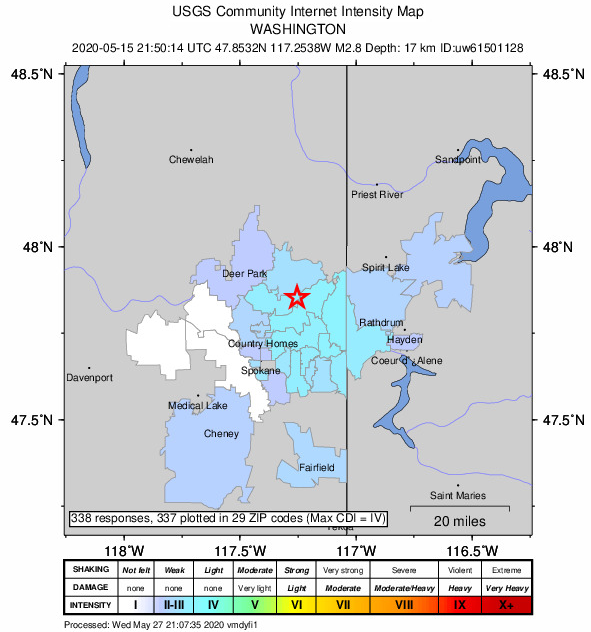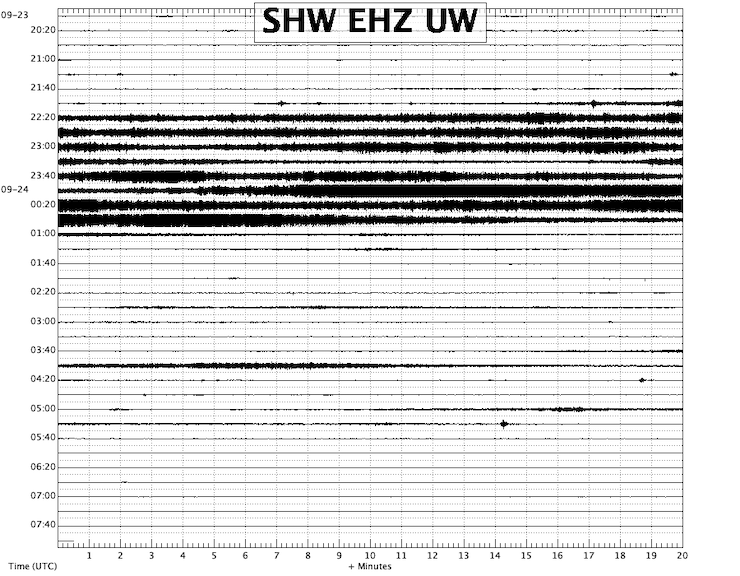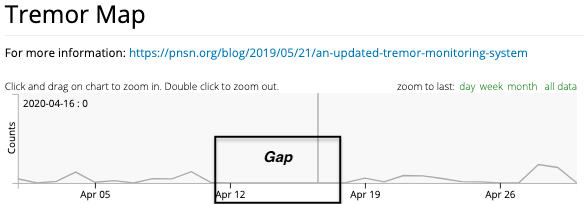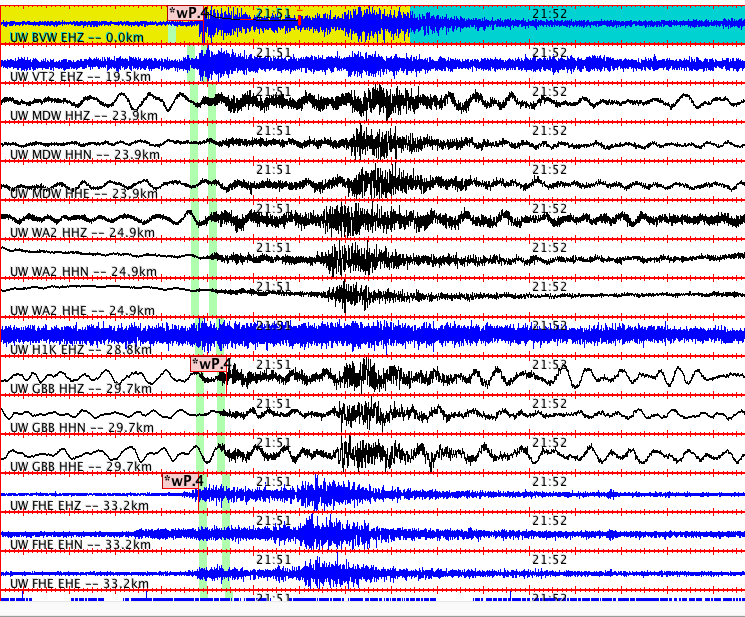The Value of Citizen Scientists
Here at the PNSN we have been providing information on earthquakes and other things that go bump in the night via our web pages for about 25 years. The products we offer have expanded and changed over the years as new capabilities have been developed and as new interesting signals have been analyzed. Early in our web offerings in 1996 we provided lists and maps of earthquakes and within a couple of years, plots of seismograms we called “webicorders”.

Some of our seismology colleagues at other networks warned us about showing original data. They told us that amateurs would see these data and come up with all sorts of hare-brained interpretations and predictions and spread crackpot theories that would confuse the public and make extra work in order for us to counter with legitimate interpretations. It turns out that these warnings were not needed. It is fairly rare that such off-the-wall interpretations or predictions require us to react. In fact, in the 1980s and 1990s we often had to correct the news media when they would report on some hare-brained idea of goats or headaches predicting earthquakes or volcanic eruptions. Now the media can see the original data, read explanations online from reputable sources and not get caught up in spreading totally bogus predictions. That is not to say that there are not people out there with outlandish theories and predictions. Social media channels are ripe with these. Some have their own web pages and even try to monetize their ramblings by selling predictions to gullible fans. However, this note is not to dwell on this aspect of the citizen non-scientist but rather the very valuable contributions that the real citizen scientists provide to us and to science in general.
From time to time people out there in the web world write to us <pnsn@uw.edu> or comment on social media (https://www.facebook.com/thePNSN/) or on Twitter: (https://twitter.com/pnsn1) with questions or comments on what they see (or don’t see) on our web pages. Another place to engage in more in-depth discussion of all manner of PNW earthquake topics is the Pacific Northwest Earthquake Discussion Group on Facebook (https://www.facebook.com/groups/thepnsn). Unfortunately some questioners are reacting to what they have read from crackpot social media channels and are asking for our explanations rather than being willing to do their own research by looking at reputable web pages and going a bit deeper. While we do try to help with legitimate questions, too often our answers are to reiterate previous explanations.
That being said there are more than a few cases where the questions or comments have been very insightful and useful. It never hurts to get a different set of eyes on our data and analysis. Science is often advanced by questions being asked when something doesn’t seem to make sense to new observers. I will give a few recent examples of such cases.
1. Several months ago one of our regular followers sent an e-mail note <pnsn@uw.edu> about our tremor detection and mapping system producing no locations for several days. J McB often asks us questions about tremor because he watches our products frequently. (J McB is fairly self-effacing in claiming he is no scientist, but, while he is perhaps without a formal scientific education, I think, based on his comments and questions, he has all the hallmarks of a curious and critical thinker, exactly what it takes to be a good scientist).
My first reaction to his observation of “no tremor for three days” was to think, “This happens from time to time so no big deal.” However, I did look more closely at some of the intermediate analysis products and found evidence of a subtle problem with much of our realtime seismic data. In fact, while subtle, it probably was affecting other parts of our automatic analysis systems. I immediately sounded a “red alert” to our technical staff resulting in all hands on deck to find and deal with the problem. For almost two hours a team of computer systems analysts, programmers, seismic analysts and seismologists, all coordinating over a zoom session, searched for, found and fixed the problem. Since it had been going on for several days, it required us to go back and look more carefully at all previous automatic analysis and do some minor adjusting to our catalogs and products. Thanks to this citizen scientist asking an insightful question our problem was relatively short-lived.
2. On the afternoon of May 15, 2020 our FaceBook Group (https://facebook.com/groups/thepnsn) came alive with a series of posts about feeling an earthquake near Spokane, WA, but nothing was reported in the PNSN recent events catalog (https://www.pnsn.org/earthquakes/recent). After several hours of confusion about what had or had not occurred, problems with the PNSN automatic system and even our review and analysis procedures were unraveled and our catalog was updated. A later post by Patty T summarizes the confusion thus:
“Today at 2:50 PM Quake Feed registered a 2.9 in Royal City, WA 155 miles away (from Spokane). Locals felt a large boom heading from Spokane Valley to Idaho. 7 hours later they confirmed an earthquake in Mean, WA 25 miles away (from Spokane). The location took 7 hours to confirm and changed by 225 miles (sic). It was changed on the Quake Feed app.
Is this perfectly normal, and I’m misunderstanding how they are detected or the precision? It seems odd and…”
While the real problem was originally generated by technical problems at the PNSN (see below) the confusion illustrated on the many FaceBook group posts did get our attention and caused us to try and track down what was really going on. Some of the confusion was exacerbated by our former Director, Dr. John Vidale, who was trying to explain why a small earthquake near Royal City could not possibly be felt near Spokane. After the problem was found and we posted a revised catalog John kindly followed up with the following post the next day:
Yes, color me embarrassed.
I'd note, however, that this is in the under-covered far eastern region of Washington, the event was clearly recorded anyway, and there was a fairly rare sequence by which the automatic location misled whoever first took a closer look. So we're glad you persisted, do point out and question inconsistencies. I'm actually not aware of any previous instances of missing a felt earthquake in the PNSN authoritative region for many hours.
Indeed the PNSN was even more embarrassed but equally thankful for our “fans” asking the questions that got us looking more carefully. Following are the nitty gritty details of what and why things went wrong.
To start with earlier on May 15 there had been a Mag=6.4 earthquake in central Nevada with a very vigorous aftershock sequence. While these earthquakes are outside the PNSN authoritative region their seismic waves showed up on many of our network seismic stations. Our automatic detection system triggered and recorded many of these events for later manual analysis. Our computers are also programmed to “pick” the times of first arriving seismic waves and try to compute locations and magnitude estimates automatically. Of the more than 600 earthquakes that the authoritative Nevada network reported on May 15 in this sequence we triggered on 43 and ultimately manually analyzed 14 of the larger events along with 28 events within our authoritative region. That is to say our seismologists were very busy. When the automatic system reported a local earthquake near Royal City our duty seismologist glanced at the location and presented waveforms and confirmed it was a valid earthquake and could be published on our web catalog. Here are the waveforms presented:
At first glance there would be no reason to suspect that the computer got it terribly wrong. Because of a mix of seismic arrivals from the real earthquake that was near Spokane and the more distant earthquakes in Nevada the computer got fooled. After seeing the confusion rampant on our FaceBook Group we started digging deeper. After reviewing other ways of looking at seismograms and re-loading selected traces into our analysis programs we could see that stations closer to Spokane actually had good arrivals earlier than those near Royal City. Here is the equivalent set of more appropriate waveforms:

Manual re-analysis of these additional data resulted in a location 15 miles NE of Spokane. Even then the location cannot be determined with as much accuracy as those in other parts of the Pacific Northwest, because we have no seismic stations close by. We probably would have eventually found the bogus location and corrected it during the final analysis step of our procedures, but because the Citizen Scientists raised questions about our catalog right off, we were alerted to an issue sooner than later. The 338 people reporting this earthquake being felt near Spokane through the DYFI page (see below) would have surely alerted us to a problem eventually.

3. A couple of weeks ago (Sep 23) Lisa H. sent an e-mail to us inquiring about the colors of our Near-Real-Time plots (http://assets.pnsn.org/realtimeplots/). and something that seemed to be lots of “tremors”. By the way, the colors have no significance; they are just to aid the eye in differentiating the different traces. These sorts of plots are generally not that great for interpreting what is happening. The plot is only ten minutes long, cannot be re-created and is for stations that are very far apart from one another. It is really only somewhat interesting just after a relatively large event takes place, so that one can watch the seismic waves arrive at the different stations over time. Here is a copy of the plot that Lisa sent to us:
—— 
Yes, it looks dramatic, but it turns out that all of that apparent shaking is just from one station, SHW. A glitch in the plotting routine introduced a hole in the data for most stations for a short time. When I first looked at this I knew a major rain/wind storm was going on at this time and first thought it was just “wind” noise (ground shaking due to wind gusts). But I decided to look closer and realized that SHW was very strongly affected as well as some other stations on and near Mount St. Helens, while stations away from the mountain only showed low “wind” noise. These signals actually came and went over a period of a couple of hours. Here is a more traditional “webicorder” record of several hours around this period at SHW (Time on the left is in GMT which is 7 hours ahead of local PDT). This is followed by a set of seismograms one hour long for five stations at Mount St. Helens, (SHW, STD, and EDM are on the flanks, HSR is high on the south side and VALT is in the crater).


Looking at these records I knew it was something much more than just wind and more likely some sort of flood or mild debris flow signals. I contacted our colleagues at the US Geological Survey Cascade Volcano Observatory (USGS CVO), and their lead seismologist, Wes Thelen, reported that they knew about this event right off. In particular they have special, high-frequency seismographs called “Acoustic Flow Monitors” (AFMs) that had reported debris flows during this period in both the North Fork and the South Fork of the Toutle River. Wes sent me a plot showing the level and timing of these signals.

Debris flows can be generated when heavy rain falls on slopes with little vegetation and loose soils, as is typical on the slopes of Mount St. Helens. Such events are expected from time to time, and thus CVO is primed to detect and interpret them. While CVO knew about these events right off it took a Citizen Scientist to call our attention to something unusual before we dug into it enough to understand what was going on. This seemed to get enough public attention that KOMO-TV even wrote up a blog-post on it.
The PNSN staff are very busy installing and repairing seismic stations, reviewing data, doing research and producing any number of products including some seen on our web pages. While we do check on the many automatic web products from time to time it is very handy to have other sets of eyes on them. There are many cases other than those listed above where Citizen Scientists have either called attention to something that seems broken or doesn’t seem right, or they just see something out of the ordinary. While some questions could be answered by just digging a bit deeper in our many different web pages we are very happy to try to answer those that have not been answered elsewhere and are particularly happy when problems with our web pages are pointed out so that we can try to fix them.

